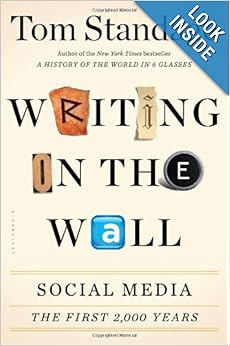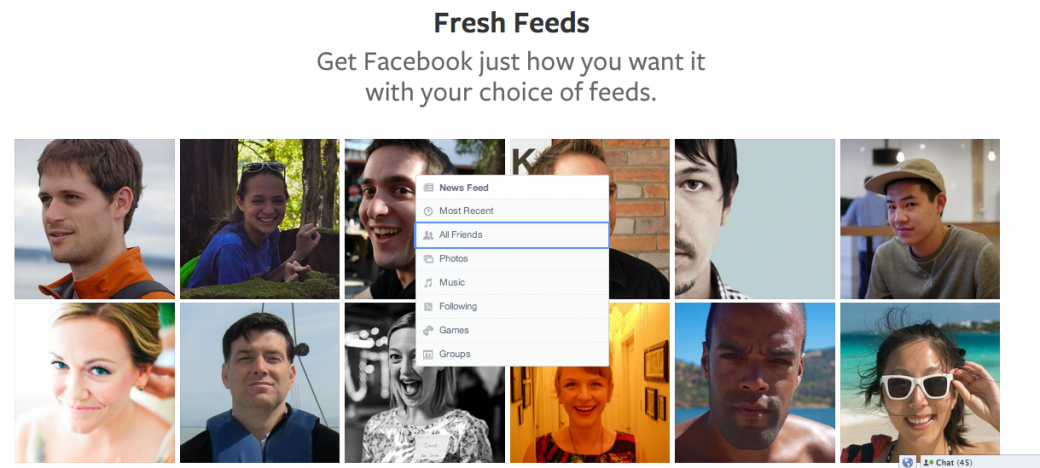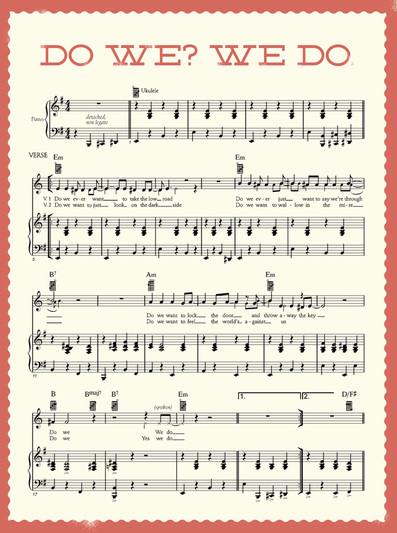If you’d asked me two months ago who I’d have around for dinner in one of those fantasy dinner guest arrangements, I’d have said, listed chronologically:
- Solomon
- Cicero
- Jesus
- Paul
- Augustine
- Luther
- Marshall McLuhan
While I reckon that’d be a pretty interesting group of guests, I realise it isn’t the sort of group that appeals to everybody. They appeal to me because they are people, communicators in fact, who loomed large in my Masters project. Which was a look at how communication mediums and technology have been harnessed by Christians (and their Jewish predecessors) to communicate to people about God. You can read my project here to see where I went – it informs my excitement about this new book.
After this week, I think I’d squeeze in an extra dinner guest. Tom Standage. Eight is a better number for dinner anyway.
I’d invite him as much for his sake as for mine – because having read his new book Writing on the Wall: Social Media – The First 2,000 Years, I suspect his list of dinner guests would be pretty similar to mine. But I also reckon he’s a pretty fascinating thinker – his other books include telling the story of world history through food
and drink
, and he’s an editor at The Economist. And we all know journalists make the best dinner guests…
A little preamble to explain my excitement about this book
You might have caught this post last week, featuring a presentation Tom Standage made at a TEDx about Cicero and social media, where I talked about how Paul was a pretty efficient user of social media too.
Cicero is a pretty fascinating guy – and, for what it’s worth, in my project I argue that he was pretty influential, directly, on how Paul approached communication, especially oratory, as a Christian. I think his letters to the Corinthian church – a city enamoured with sophistic oratory (all flash, no substance) draw from Cicero’s writings about oratory to critique the Corinthian’s buying into Sophistic standards by suggesting that Jesus was the ideal orator who should be imitated. There’s another link between Paul and Cicero – the city of Tarsus. The capital of Cilicia.
Very few people have bothered to make any connection between Paul and Cicero – because most modern Biblical scholars assume that Paul was an idiot. Because he calls himself one (quite literally – it’s the Greek word he uses in 2 Corinthians 11:6). But there are incredible overlaps in the terminology they use, in their critique of other forms of oratory, their emphasis and use of ethos and character in persuasion, and in the position they implicitly or explicitly adopt towards the Roman Empire. There’s a huge similarity in their communication praxis. And one thing modern Biblical scholars fail to explain is how Paul, if he’s an idiot, managed to be one of the most effective communicators of all time…
So it was exciting to me that Writing on the Wall opened with…
In July 51 B.C. the Roman statesman and orator Marcus Tullius Cicero arrived in Cilicia, in what is now southeast Turkey, to take up the post of proconsul, or regional governor.
He gets to Paul, he talks about Luther (in fact, it was an article he wrote about Luther’s use of pamphlets in the Reformation, that forms part of this book, that inspired a significant part of my project). The book offers a fascinating approach to the use of media through history by different groups or in support of different causes – it is massively useful for people who want to think about how they might participate in spreading any sort of message (ie Christianity), and it’s an interesting look at how the world works. I’m not just saying this because it meshes, pretty substantially, with what I already thought… Standage is a pretty compelling storyteller, and has weaved some incredible threads through history together into a rich picture of the way media works – and the way people work with media. There’s lots to learn, and a fair bit to digest. I like to highlight interesting passages as I read on my kindle, and I refer back to my highlighted passages more than the book itself – this book was more highlight than text when I finished.
I mentioned Marshall McLuhan as one of my dinner guests – he’s a guy a lot of media studies people now hold up as some sort of oracle, because he, somewhat like a horoscope (in that he was so general he couldn’t fail) – predicted the Internet and social media (the “Global Village”) before its time. I like McLuhan mostly because he makes some nice quasi-theological (or actually theological at times) observations about the impact of media on its users, and the importance of harnessing new, complementary, mediums for advancing a message.
He said, at one point:
“Any change in the forms or channels of communication, be it writing, roads, carts, ships, stone, papyrus, clay, or parchment, any change whatever has revolutionary social and political consequences.”
The empires that survive or thrive, through history – are those that figure out how to use these mediums. This is powerfully demonstrated in Writing On The Wall – not just at the “empire” level, but at the level of communicating ideas. McLuhan drew largely on a book called Communication and Empire by Harold Innis, which is a profoundly interesting companion to Writing on the Wall (and is available in full from Project Gutenberg).
Standage’s treatment of social media throughout the ages features Cicero, Paul and early Christianity, seditious and salacious poetry in the British court, the independence movement in the United States, the importance of coffee houses in the developing, fermenting, and sharing of ideas, and the rise of pamphlets, journals and newspapers, then the Internet – it tracks the fascinating movement from media being the voice of the people, to people being the commodity sold by centralised media, to advertisers. It’s profoundly useful, and very interesting.
You should read it.
Reading as conversation: what really excited me about reading this book
But what really excited me about reading this book – was the way social media augmented the reading process. There’s quite a bit of stuff written out there about how social media is changing the way we read and experience texts. An example would be Nicholas Carr’s The Shallows: What the Internet Is Doing to Our Brains. Which spends a significant amount of time quoting McLuhan.
And it’s true. Often these are quite pessimistic – they tend to lament the halcyon days of long attention spans, and being cloistered somewhere with a hard copy book. Interestingly – Standage shows in Writing On The Wall that the introduction of every new medium sees the same old criticisms rehashed (and this idea isn’t all that new – there’s even an XKCD comic about this, and I wrote about it somewhere)…
Enthusiasm for coffee houses was not universal, however, and some observers regarded them as a worrying development. They grumbled that Christians had taken to a Muslim drink instead of traditional English beer, and fretted that the livelihoods of tavern-keepers might be threatened. But most of all they lamented, like critics of social media today, that coffee houses were distracting people and encouraging them to waste time sharing trivia with their friends when they ought to be doing useful. – Writing On The Wall
I think most of us are a little bit inconsistent in our thinking here – and we’re happy to be inconsistent. Even early adopters. A nice example of this can be found in two essays by Nicholson Baker, published in the same book of essays – The Way the World Works: Essays – a significant number of essays in this book (also a great read) are devoted to Baker’s attempts to conserve physical media – particularly Newspapers, but also old library books, one essay is about how to read a book. A tactile book. And yet, he also writes and essay celebrating Wikipedia, talking about his addiction to editing and contributing to the online encyclopedia. He’s probably the champion of preserving physical media – he may be the closest thing to a literary luddite – and yet, he writes a celebration of the site that killed the printed Encyclopedia. He also writes a celebration of reading on the iPhone (while writing off the original Kindle).
Anyway. McLuhan, and Carr are right. New mediums change the way we experience texts, and life. And I think this is exciting (which puts me firmly in the optimist camp when it comes to this debate). Baker is right – new mediums owe a profound debt, that we shouldn’t forget, to old mediums. But Standage has something more to add – the more things change, the more they stay the same – experiencing texts has almost always been a social activity. When the social element is removed from the communication equation – namely, when participants become the product, not the audience – something is missing in how media is being produced. This missing “social” aspect is something essential to communication. Why write something down if it’s not to be transmitted to, and experienced by somebody else? An audience. Communication is inherently social. Social media is, at this point, simply helping a text reaching its natural end. Faster. With great efficiency.
So texts should be being produced to be shared and discussed. And social media – as we currently know it – survives and thrives when this happens.
So, because I was already excited about the book’s material, and had already put a fair amount of thought into the subject matter, I thought why not read this book as though it’s a conversation with Tom Standage. And why not make it one. He’s on Twitter. I’m on Twitter.
He’d even already responded to a couple of things I’d tweeted him while anticipating Writing On The Wall’s release.
I read Writing On The Wall as an ebook, on my iPad, in the Kindle app. And as I read, when I found things that excited me, or had questions, I tweeted @tomstandage. He seems like the kind of guy you’d want at a dinner party. So he tweeted back.
And this is what excited me most about reading Writing On The Wall. It’s what excites me about social media being a tool that breaks down distance, and allows people who share interests to discuss things from opposite points on the globe. Sure – you’ve always been able, in a round about way, to write to an author. To send fan mail. To ask questions. To publish in response – but never like we’ve been able to now.
This exercise, where I’m publishing a review of a book on my blog, this is the continuation of a book promotion strategy that began in ancient Rome – but the ease with which this will be shared by people who are interested, and the link this contains to a place where you can buy the ebook, and start reading it right now. That’s amazing. Time and space have truly collapsed.
The distance between author and reader has collapsed. I started tweeting Tom about this book the day it was released. The day I started reading it. I tweeted him as I read it. Day after day. We chased tangents. Shared our passion for Cicero. And the content of the book – while excellent when contained in the book – came alive a little more as I asked questions, and received answers. I was even able to share a quote from Luther, one of his letters, that given the response, seemed new to Tom. I’ve even just started calling him “Tom” in this paragraph – such is the added familiarity or breakdown in formality this experience created. I’m not reviewing this book as someone with an academic interest in the book – though I have that (and the extensive bibliography at the end of the book was pretty exciting to me). I’m reviewing it as a guy who feels like he spent the week talking to another person. The author. And that is something. Something different. Something exciting. For me it demonstrated the substantial premise of the book better than the content itself – we people are wired to be social, and the networks we create or in which we function as nodes, and the ‘media’ that brings such nodes together work best when medium, message, and participants come together in harmony (where medium and message are in sync) and without impediment.
Talking about reading Writing On The Wall
I’ll understand if you’re already over this post – but before you check out, I do want to thank Tom for talking to me (via Twitter). He seems like a really nice guy. And Tom – if you’re reading – feel free to take me up on the dinner offer. The other guys are dead though (except for Jesus, but he’s elsewhere). So I think it’ll just be you and me.
So here are some highlights from our conversation. Starting when I read a post on his blog about Cicero… Before I started reading the book – because social media, in this case, actually extended the experiencing of the book beyond the actual reading of the book. Which again, serves to demonstrate the principle in question – and is another nice parallel to Cicero’s approach to promoting books.
Hi @tomstandage, your terrific how the Reformation Went Viral story from a while ago spawned my Masters project. Wanted to say thanks.
— Nathan Campbell (@nm_campbell) September 27, 2013
@tomstandage also – I have a working theory that Cicero heavily influenced the Apostle Paul – looking forward to reading Writing on the Wall
— Nathan Campbell (@nm_campbell) September 27, 2013
@nm_campbell What sort of influence? Literary style? Travel in Asia Minor?
— Tom Standage (@tomstandage) September 27, 2013
@tomstandage Cicero was governor of Cilicia just after writing De Oratore, I reckon you can source criticise some of Paul’s approach
— Nathan Campbell (@nm_campbell) September 27, 2013
@tomstandage my theory is that Paul trained at a rhetorical school in Tarsus, that used Cicero’s books as textbooks.
— Nathan Campbell (@nm_campbell) September 27, 2013
@nm_campbell Fascinating!
— Tom Standage (@tomstandage) September 27, 2013
@tomstandage probably similar use of “social media” too, with the “epistle” form. Both anti-imperial, big on ethos. But big differences.
— Nathan Campbell (@nm_campbell) September 27, 2013
@nm_campbell Right. Cicero is trying to preserve the status quo; Paul is an insurgent
— Tom Standage (@tomstandage) September 27, 2013
@tomstandage also very different views on the social status of crucifixion. Paul seems to pull oratory through that grid.
— Nathan Campbell (@nm_campbell) September 27, 2013
@tomstandage anyway. Love that Cicero features in the book. Very much looking forward to it.
— Nathan Campbell (@nm_campbell) September 27, 2013
This is when I wrote the post about Paul as a social media pioneer – ignorant of what was in Writing On The Wall about Paul…
Blogging: Cicero and the Apostle Paul as social media pioneers http://t.co/1dx7PU7Jr2
— Nathan Campbell (@nm_campbell) September 28, 2013
Cicero and the apostle Paul as social-media pioneers by @nm_campbell http://t.co/gSOsbCROrw << BTW, Paul *is* in my book
— Tom Standage (@tomstandage) September 28, 2013
And here’s where I actually started reading the book.
This book about social media in the ancient world is out today. From @tomstandage. I’m looking forward to reading it: http://t.co/hGzvFRJ46r
— Nathan Campbell (@nm_campbell) October 10, 2013
.@nm_campbell Thanks! It’s the UK Kindle edition of “Writing on the Wall” that is out today — US editions next week http://t.co/qLRDscKQq4
— Tom Standage (@tomstandage) October 10, 2013
@tomstandage now finished Luther bit – also great. Slightly sad you didn’t mention his font snobbery (http://t.co/XQ0Go4jnKF).
— Nathan Campbell (@nm_campbell) October 10, 2013
@nm_campbell Yes, perhaps I should have explained that he complained about printers, even as he benefited from them
— Tom Standage (@tomstandage) October 10, 2013
Here’s where I asked Tom a question about something not in the book, which I reckon is a nice piece of support for his argument (and where my project had gone a little more – the use of imagery to complement text/spoken stuff by providing visual representations of “ethos”)…
@tomstandage did you consider image based Roman FB precursors like coins and family statues where people depict themselves being impressive
— Nathan Campbell (@nm_campbell) October 10, 2013
@nm_campbell Not really — coins were a form of social media (see http://t.co/BeGtJhsxK5) but statues cannot be copied/shared by friends!
— Tom Standage (@tomstandage) October 10, 2013
@tomstandage instagram photos can’t be natively shared yet either (can on FB). There’s a “look at the awesone life I’ve built” aspect also
— Nathan Campbell (@nm_campbell) October 10, 2013
@nm_campbell No native sharing, true, but your friends can see what you Liked, which is a form of sharing. And agreed on “awesome life”
— Tom Standage (@tomstandage) October 10, 2013
@tomstandage similar to how brands use FB etc. I reckon there’s a tight link between image, ethos & brand. Cicero leveraged this in speeches
— Nathan Campbell (@nm_campbell) October 11, 2013
@nm_campbell Yes, I see what you mean. Statues as social media!
— Tom Standage (@tomstandage) October 11, 2013
@nm_campbell I didn’t mention the way Romans were judged in the forum by how many followers they had. But they were!
— Tom Standage (@tomstandage) October 11, 2013
@tomstandage there’s a great line in Acts about people in the Athenian marketplace doing nothing but talking about the latest ideas. YouTube
— Nathan Campbell (@nm_campbell) October 12, 2013
@tomstandage now up to coffee houses – another subject dear to my heart. My favourite anti-coffee house propaganda: http://t.co/QbpmftQARG
— Nathan Campbell (@nm_campbell) October 12, 2013
@nm_campbell Yes, another of my favourite bits. Off to make coffee now!
— Tom Standage (@tomstandage) October 12, 2013
We talked a little bit about Machiavelli, Cicero’s brother’s guide to winning elections, and Marhsall McLuhan (he’s less of a fan than I am) – but I’m trying not to post everything. As you can see, he was quite generous with his time, and patient with a young punk from Australia lobbing him just about everything that sprang to mind while reading his book…
@nm_campbell Very glad you enjoyed it — thanks for live-tweeting your reading of it!
— Tom Standage (@tomstandage) October 12, 2013
@tomstandage that’ll be part of the review. It’s the first time I’ve read a book while in conversation with the author. Quite meta.
— Nathan Campbell (@nm_campbell) October 12, 2013
@nm_campbell Likewise, the first time I’ve watched someone read one of my books while in conversation with them! (1/2)
— Tom Standage (@tomstandage) October 12, 2013
@nm_campbell Kindle highlights are also interesting for authors; readers talk back and tell you what they liked most! Two-way traffic! (2/2)
— Tom Standage (@tomstandage) October 12, 2013
And this is where it gets more meta. Because I was tweeting him as I wrote this review…
@tomstandage I read an essay by Nicholson Baker about his habit of writing out paragraphs he liked (similar to a commonplace book).
— Nathan Campbell (@nm_campbell) October 13, 2013
The commonplace book features in Writing On The Wall…
@tomstandage he hand copied them & collected them as inspiration. Which I quite like (though this is less tactile).
— Nathan Campbell (@nm_campbell) October 13, 2013
@tomstandage but also interesting to see what others highlight. as a preacher it’s interesting to see what bits of the Bible people like.
— Nathan Campbell (@nm_campbell) October 13, 2013
There’s lots to love about Writing On The Wall, and every criticism I had, or that I anticipated making, as I read was tied up as a loose end or answered by the bibliography. There were times that I wanted to dig deeper or find out a source – these times are more than adequately addressed by the end of the book. And if you’ve got more questions, you can always do what I did – and ask the author. Because that’s a social reading experience – and medium and message wouldn’t add up like they do in this case if @tomstandage was an anti-social type.

















